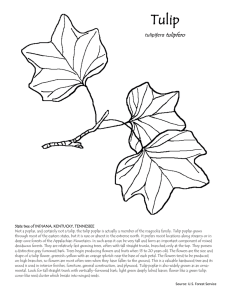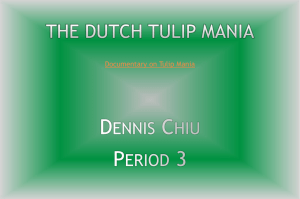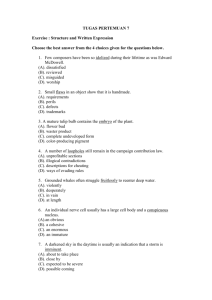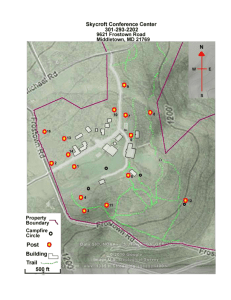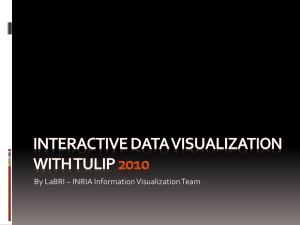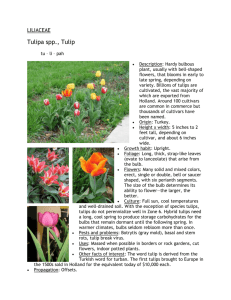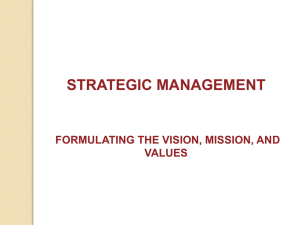Reconceiving and Repackaging Journal Information for Electronic
advertisement
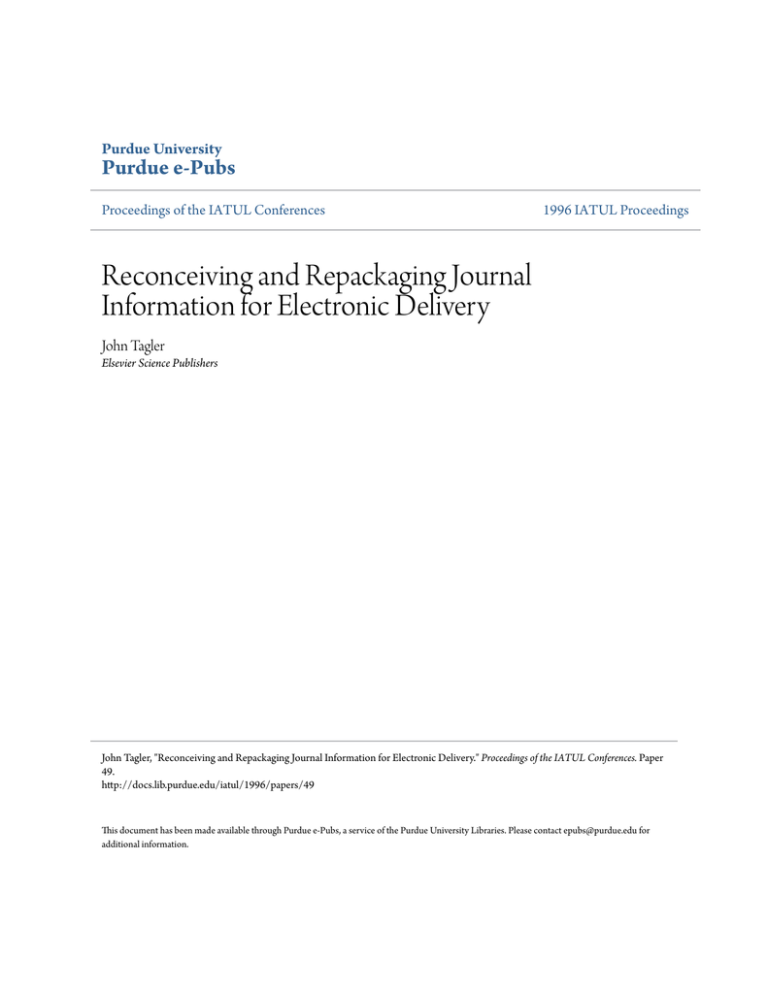
Purdue University Purdue e-Pubs Proceedings of the IATUL Conferences 1996 IATUL Proceedings Reconceiving and Repackaging Journal Information for Electronic Delivery John Tagler Elsevier Science Publishers John Tagler, "Reconceiving and Repackaging Journal Information for Electronic Delivery." Proceedings of the IATUL Conferences. Paper 49. http://docs.lib.purdue.edu/iatul/1996/papers/49 This document has been made available through Purdue e-Pubs, a service of the Purdue University Libraries. Please contact epubs@purdue.edu for additional information. Repackaging Journal Information for Electronic Delivery Tagler, John Elsevier Science, New York, USA I am very pleased to be invited here today to speculate about the future of the scholarly journal and the research library. This topic is by no means new -- for years, in fact, librarians and publishers have been pondering the possibilities and implications of electronic full-text delivery. But now many of us have some first-hand experience with electronic delivery, offering us a clearer view of where we’re headed. Three Considerations Today I want to look at three areas. (1) With TULIP having just recently completed its four-year experimental run, I want to share some of the experience we have learned from that project. (2) At Elsevier Science we have also gained considerable experience with a variety of different electronic products each of which has distinct functionalities; individually and collectively they offer a number of lessons. (3) Finally, the question that concerns most of us present here today -- what roles do publishers and librarians play in this new scenario? 1. The TULIP Learning Curve TULIP (The University LIcensing Project) has been widely documented so I’ll just briefly recap the framework within which it operated. It was a large-scale experiment, running from 1991 - 1995, to bring scientific journals to the researcher’s desktop in electronic form. TULIP was a collaborative project between Elsevier Science and 9 major universities in the USA to test the (1) technical, (2) organizational, (3) economic and (4) user-behavior aspects of using campus networks and the Internet for large-file text delivery. Each university selected and provided its own local hardware and software infrastructure. Each TULIP implementation placed emphasis on different storage, retrieval, display and printing features. There was not one, but nine, TULIP operations. The project involved 43 Elsevier materials science and engineering journals published during 1992 - 1995 with the output per year averaging well over 100,000 text pages. TULIP Delivered The electronic files consisted of: • • • TIFF bit-mapped page images, scanned at 300 dpi, Group IV fax compression, edited and structured ASCII “heads”, including bibliographic citations and abstracts, unedited OCR-generated ASCII full text (“dirty” ASCII) TULIP Some Lessons Learned What were some of the lessons learned during TULIP’s four-year experiment? First, implementations are harder than expected, but participants have said that TULIP helped them face problems that needed to be dealt with sooner or later. With the TULIP experience under their belt, they are ahead of their peers in handling electronic files. Second, Internet delivery of large-scale sets of images does not scale anytime soon (e.g., in TULIP’s case 4000-page images every two weeks). Transmissions take very long; even after working out the kinks of the initial transmissions, the files could take as long as 4 - 6 hours, biweekly, to transmit. A preferable alternative for the present is to deliver such large-image files on a CD-ROM which can be loaded to a server onsite. Third, user interfaces are crucial for acceptance of a system. At the outset, finding a system to work across a variety of platforms posed a hurdle. Web browsers have now essentially eliminated this problem. Finally, no system, regardless of how well-conceived, is successful if its users are unreceptive to its concept and unmotivated to its use. The sites where TULIP was most eagerly embraced by the end-users were those where promotion and training were supported by the library. Interestingly, graduate students tended to be the early adopters and therefore key to widespread use of the system. Our initial in-dept research into user behavior was at the University of Michigan, and let me share some of our findings with you. Usage Levels at Univ of Michigan In terms of actual usage: • • • 70% of the 360 potential users used TULIP at least once. 15% of these can be defined as repeat users. There was a pattern of steadily increasing number of repeat users over the time of the experiment. TULIP User Feedback In focus groups and interviews, users provided substantive pointers to guide us in expanding the availability of these files: • • • • • • The electronic files were seen as an addition to the paper archives, not a replacement. Users really like TULIP but recognize several limitations: the concept of electronic delivery continues to have pitfalls. Even with Elsevier’s extensive collection of 43 major materials science journals, the collection was perceived as lacking critical mass. Printing problems continue to pose difficulties at the work station. The quality of images and electromicrographs needs improvement. Users complained that they were “too busy to learn it” - a complaint not uncommon to many new electronic services in the busy research environment. 2. The Future: Adapting to Changes in User Needs and Technology The notion of ongoing changes in the balance between paper and electronic information leads me to my second point -- changes in and enhancement of the information being delivered. Immunology Today Online & Vaccine Online In terms of full-text journal information, Elsevier Science has approached different functionalities to satisfy the research patterns of users in different disciplines who require different types of publications. Among the electronic products of journal enhancements that we introduced in the past year are: Immunology Today Online (ITO) and Vaccine Online. Immunology Today Online was in the launched in early 1995 followed by Vaccine Online that fall. While the two publications differ somewhat in nature (IT is a monthly publication offering topical review articles and news items, while Vaccine is a primary journal), both are pre-eminent publications in fields of fast-moving research. The online versions offer everything the print journal contains plus electronic enhancements: • • • • • Direct delivery to the reader’s desktop where fully searchable articles ensure that every word in every article can be searched with a full range of Boolean and proximity operators. Users can identify published articles with a common theme from the entire database or browse the most recent issue. Hypertext-linked abstracts mean that while reading an article, users may jump to an article reference and the access its abstract linked from the EMBASE database. Facilitated e-mail permits links with editorial teams to enable comments and questions. For ITO, links to news developments, product information and classified jobs listings enhance the publication’s value as a current reference tool. Gene-COMBIS Gene-COMBIS is a peer-reviewed online enhancement to the print journal Gene allowing access to a new cluster of articles. Focusing on papers in computational molecular biology, submission of paper into this electronic environment begins with electronic submission of a manuscript. A submission may be accompanied by newly derived gene sequence or protein structure data or it may simply make reference to sequences or structures already in discipline-specific databases (e.g., Gen Bank, EDJ or DDBJ). As with ITO and Vaccine, links to EMBASE allow ready access to citations and expand to three major genetics data bases. Upon a paper’s acceptance, notation is made within the relevant database to indicate when a sequence had been verified. At the same time an accepted paper is datestamped and made available online to journal subscribers with appropriate hypertext links to the gene structure or protein sequence data referenced. Tetrahedron Alert Taking yet a different approach, Tetrahedron Alert represents the first phase of the new online Tetrahedron Information System. The alerting service, launched last fall, provides desk top access to tables of contents and graphical abstracts of accepted peer-reviewed papers four weeks prior to publication of the printed journal issue. Among the features and functions that it offers are: • • • • • • Desktop access and printing is available to users 24 hours a day. Users can choose how they want to view the contents -- either traditionally or graphically. The latter allows users to scroll through the graphical schemes and exploit any that are of interest, turning these schemes into full textual and graphical abstracts. Tet Alert is fully searchable across an individual journal issue or a collection of issues, whether for one particular journal or all five of the Tetrahedron titles. A search is available, using Boolean operates across title, author, abstract and keyword. To make things easier and quicker for users, there are hotlist and bookmark facilities that allow users to return to designated terms and perform automatic searches on the latest information in the database. The ability to click on an author, page number or abstract with links to further information in Tet Alert via hypertext functions. For example, if you are viewing an abstract and want to see if one of the authors has written anything else in the Tet Alert database, you can receive a list of all the papers where that author is listed. Tet Alert is the first step toward providing all five Tetrahedron journals electronically. The first will be Tetrahedron Letters Online, scheduled for launch this year, which will provide not only the graphical abstracts and full bibliographic information but also the full text of all papers accepted for publication in Tetrahedron Letters. New Astronomy You will note that all of the products described above are adaptations of traditional print product. That has largely been our focus in electronic product development -- to see how established titles, with strong editorial identities, adapt electronically in a changing environment. But we have also taken the jump recently in announcing a totally electronic new journal. Earlier this year we announced New Astronomy which will be fully electronic and available on the Web. As with most electronic journals, it provides electronic manuscript submission and aims at a very short publication time. The refereeing process will be speedy and articles will be available electronically, immediately upon acceptance. However, to reassure any skeptics about the archivability of this electronic journal, a paper edition will also be published. 3. Librarians and Publishers in the New Scenario What have our experiences with these preliminary steps taught us so far? Well, first of all, they have emphasized the importance of experimentation and research. There is a long learning curve ahead and it is critical for all parties involved -- scientist, librarian and publisher -- to begin taking those pioneer steps that are crucial to understanding the demands and possibilities of the electronic future. While there have been many stones thrown at the future roles of libraries and publishers, the services that both have rendered for centuries will continue to be performed. There is great transformation underway as to how these services are being executed and even as to who may ultimately be rendering them. But both areas of responsibility will continue to be performed in response to the needs of the scientific community, where quality of information and speed of delivery are under increased pressure. In response to this, the following trends become more important: • There is increasing pressure to release information quickly. This is abetted in two ways. (1) Electronic peer review offers important inroads by accelerating this process while continuing to maintain quality control standards. (2) Electronic dispatch offers the possibility of not having to wait for production in paper format or collecting enough papers to produce a printed issue. In an environment where, to some people, publishing may mean mounting something on the Internet, the demand for quality control will be increasingly valued. • • • • Print editions will not necessarily become extinct; they just won’t serve the urgent needs of fast-moving research. There remain obstacles to long-term electronic archiving, and print is still every reassuring to many people. The subscription approach, particularly considering the large-scale information requirements of many research institutions, continues to be the most feasible in terms of logistics and economics. The concept of the subscription product or framework may change but the model of packaging remains viable. It is becoming increasingly obvious that partnership arrangements are necessary to sustain and improve large-scale electronic delivery. Gone are the days of launching a quarterly journal and marketing it to end-users and libraries. The expensive, complex, sensitive infrastructure necessary to serve electronic communication requires a great and continued investment in terms of money, time, standards, staff and ongoing development. When we consider this on an international scale -- and science is nothing if not increasingly international -- the imagination reels. No one can maintain this independently and it is only through cooperation and shared resources and learning that the task is feasible. Within this scenario, gatekeeper roles become more important. First the publisher is the gatekeeper responsible for monitoring and maintaining the quality and scope of information. Add to that the responsibility for ensuring the integrity of the information for the long term. Second, the librarian has the responsibility for monitoring the myriad options available and contracting those services and products that meet the needs of his or her user community in terms of costs, functionalities and permanence. If we consider the electronic future that contrasts the scientific publishing process as we’ve known it with that of the near future, you can’t help but realize that the world will not be getting simplified. Faster, of course. Flexible, to be sure. More alternatives, absolutely. But the knowledge and skills of those involved in maintaining this complex infrastructure are more critical than ever. And we will increasingly need skilled, experienced professionals and not amateurs at the helm at all levels.
